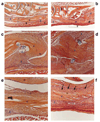Freeze-dried tendon allografts as tissue-engineering scaffolds for Gdf5 gene delivery
- PMID: 18180771
- PMCID: PMC2705193
- DOI: 10.1038/sj.mt.6300395
Freeze-dried tendon allografts as tissue-engineering scaffolds for Gdf5 gene delivery
Abstract
Tendon reconstruction using grafts often results in adhesions that limit joint flexion. These adhesions are precipitated by inflammation, fibrosis, and the paucity of tendon differentiation signals during healing. In order to study this problem, we developed a mouse model in which the flexor digitorum longus (FDL) tendon is reconstructed using a live autograft or a freeze-dried allograft, and identified growth and differentiation factor 5 (Gdf5) as a therapeutic target. In this study we have investigated the potential of rAAV-Gdf5 -loaded freeze-dried tendon allografts as "therapeutically endowed" tissue-engineering scaffolds to reduce adhesions. In reporter gene studies we have demonstrated that recombinant adeno-associated virus (rAAV)-loaded tendon allografts mediate efficient transduction of adjacent soft tissues, with expression peaking at 7 days. We have also demonstrated that the rAAV-Gdf5 vector significantly accelerates wound healing in an in vitro fibroblast scratch model and, when loaded onto freeze-dried FDL tendon allografts, improves the metatarsophalangeal (MTP) joint flexion to a significantly greater extent than the rAAV-lacZ controls do. Collectively, our data demonstrate the feasibility and efficacy of therapeutic tendon allograft processing as a novel paradigm in tissue engineering in order to address difficult clinical problems such as tendon adhesions.
Figures






Similar articles
-
Adhesions in a murine flexor tendon graft model: autograft versus allograft reconstruction.J Orthop Res. 2008 Jun;26(6):824-33. doi: 10.1002/jor.20531. J Orthop Res. 2008. PMID: 18186128 Free PMC article.
-
Freeze-dried allograft-mediated gene or protein delivery of growth and differentiation factor 5 reduces reconstructed murine flexor tendon adhesions.J Tissue Eng. 2014 Mar 19;5:2041731414528736. doi: 10.1177/2041731414528736. eCollection 2014. J Tissue Eng. 2014. PMID: 24812579 Free PMC article.
-
Remodeling of cortical bone allografts mediated by adherent rAAV-RANKL and VEGF gene therapy.Nat Med. 2005 Mar;11(3):291-7. doi: 10.1038/nm1190. Epub 2005 Feb 13. Nat Med. 2005. PMID: 15711561 Free PMC article.
-
Freeze-dried allografts for anterior cruciate ligament reconstruction.Clin Sports Med. 2007 Oct;26(4):625-37. doi: 10.1016/j.csm.2007.06.011. Clin Sports Med. 2007. PMID: 17920957 Review.
-
Gene therapy methods in bone and joint disorders. Evaluation of the adeno-associated virus vector in experimental models of articular cartilage disorders, periprosthetic osteolysis and bone healing.Acta Orthop Suppl. 2007 Apr;78(325):1-64. Acta Orthop Suppl. 2007. PMID: 17427340 Review.
Cited by
-
A Synthetic Gene Circuit for Self-Regulating Delivery of Biologic Drugs in Engineered Tissues.Tissue Eng Part A. 2019 May;25(9-10):809-820. doi: 10.1089/ten.TEA.2019.0027. Tissue Eng Part A. 2019. PMID: 30968743 Free PMC article.
-
Gene doping: the hype and the reality.Br J Pharmacol. 2008 Jun;154(3):623-31. doi: 10.1038/bjp.2008.144. Epub 2008 Apr 21. Br J Pharmacol. 2008. PMID: 18500383 Free PMC article. Review.
-
Impact of Smad3 loss of function on scarring and adhesion formation during tendon healing.J Orthop Res. 2011 May;29(5):684-93. doi: 10.1002/jor.21235. Epub 2010 Sep 14. J Orthop Res. 2011. PMID: 20842701 Free PMC article.
-
Development of antisense oligonucleotide (ASO) technology against Tgf-β signaling to prevent scarring during flexor tendon repair.J Orthop Res. 2015 Jun;33(6):859-66. doi: 10.1002/jor.22890. J Orthop Res. 2015. PMID: 25761254 Free PMC article.
-
Gene Therapy for Cartilage Repair.Cartilage. 2011 Jul;2(3):201-25. doi: 10.1177/1947603510392914. Cartilage. 2011. PMID: 26069580 Free PMC article. Review.
References
-
- Lilly SI, Messer TM. Complications after treatment of flexor tendon injuries. J Am Acad Orthop Surg. 2006;14:387–396. - PubMed
-
- Gelberman RH, Manske PR. Factors influencing flexor tendon adhesions. Hand Clin. 1985;1:35–42. - PubMed
-
- Silva MJ, Boyer MI, Gelberman RH. Recent progress in flexor tendon healing. J Orthop Sci. 2002;7:508–514. - PubMed
-
- Leddy JP. Flexor Tendons - Acute Injuries. In: Green DP, editor. Operative Hand Surgery. Vol. 3. New York: Churchill Livingstone; 1988. pp. 1935–1968.
-
- Whitlock PW, Smith TL, Poehling GG, Shilt JS, Van Dyke M. A naturally derived, cytocompatible, and architecturally optimized scaffold for tendon and ligament regeneration. Biomaterials. 2007;28:4321–4329. - PubMed
Publication types
MeSH terms
Substances
Grants and funding
LinkOut - more resources
Full Text Sources
Other Literature Sources
Medical
Research Materials

